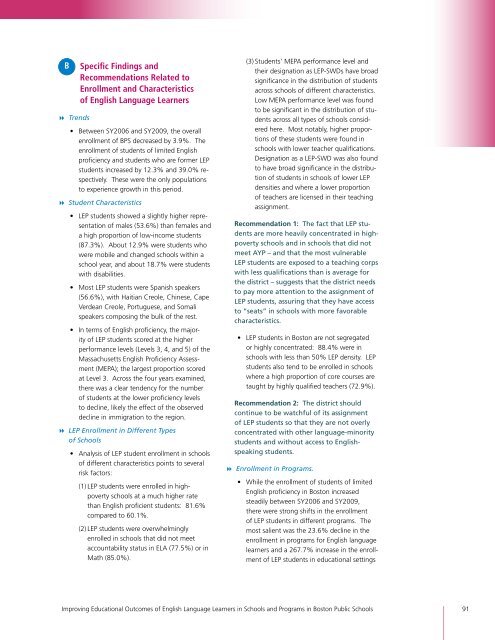Full Report - Center for Collaborative Education
Full Report - Center for Collaborative Education
Full Report - Center for Collaborative Education
You also want an ePaper? Increase the reach of your titles
YUMPU automatically turns print PDFs into web optimized ePapers that Google loves.
B Specific Findings and<br />
Recommendations Related to<br />
Enrollment and Characteristics<br />
of English Language Learners<br />
8 Trends<br />
• Between SY2006 and SY2009, the overall<br />
enrollment of BPS decreased by 3.9%. The<br />
enrollment of students of limited English<br />
proficiency and students who are <strong>for</strong>mer LEP<br />
students increased by 12.3% and 39.0% respectively.<br />
These were the only populations<br />
to experience growth in this period.<br />
8 Student Characteristics<br />
• LEP students showed a slightly higher representation<br />
of males (53.6%) than females and<br />
a high proportion of low-income students<br />
(87.3%). About 12.9% were students who<br />
were mobile and changed schools within a<br />
school year, and about 18.7% were students<br />
with disabilities.<br />
• Most LEP students were Spanish speakers<br />
(56.6%), with Haitian Creole, Chinese, Cape<br />
Verdean Creole, Portuguese, and Somali<br />
speakers composing the bulk of the rest.<br />
• In terms of English proficiency, the majority<br />
of LEP students scored at the higher<br />
per<strong>for</strong>mance levels (Levels 3, 4, and 5) of the<br />
Massachusetts English Proficiency Assessment<br />
(MEPA); the largest proportion scored<br />
at Level 3. Across the four years examined,<br />
there was a clear tendency <strong>for</strong> the number<br />
of students at the lower proficiency levels<br />
to decline, likely the effect of the observed<br />
decline in immigration to the region.<br />
8 LEP Enrollment in Different Types<br />
of Schools<br />
• Analysis of LEP student enrollment in schools<br />
of different characteristics points to several<br />
risk factors:<br />
(1) LEP students were enrolled in highpoverty<br />
schools at a much higher rate<br />
than English proficient students: 81.6%<br />
compared to 60.1%.<br />
(2) LEP students were overwhelmingly<br />
enrolled in schools that did not meet<br />
accountability status in ELA (77.5%) or in<br />
Math (85.0%).<br />
(3) Students’ MEPA per<strong>for</strong>mance level and<br />
their designation as LEP-SWDs have broad<br />
significance in the distribution of students<br />
across schools of different characteristics.<br />
Low MEPA per<strong>for</strong>mance level was found<br />
to be significant in the distribution of students<br />
across all types of schools considered<br />
here. Most notably, higher proportions<br />
of these students were found in<br />
schools with lower teacher qualifications.<br />
Designation as a LEP-SWD was also found<br />
to have broad significance in the distribution<br />
of students in schools of lower LEP<br />
densities and where a lower proportion<br />
of teachers are licensed in their teaching<br />
assignment.<br />
Recommendation 1: The fact that LEP students<br />
are more heavily concentrated in highpoverty<br />
schools and in schools that did not<br />
meet AYP – and that the most vulnerable<br />
LEP students are exposed to a teaching corps<br />
with less qualifications than is average <strong>for</strong><br />
the district – suggests that the district needs<br />
to pay more attention to the assignment of<br />
LEP students, assuring that they have access<br />
to “seats” in schools with more favorable<br />
characteristics.<br />
• LEP students in Boston are not segregated<br />
or highly concentrated: 88.4% were in<br />
schools with less than 50% LEP density. LEP<br />
students also tend to be enrolled in schools<br />
where a high proportion of core courses are<br />
taught by highly qualified teachers (72.9%).<br />
Recommendation 2: The district should<br />
continue to be watchful of its assignment<br />
of LEP students so that they are not overly<br />
concentrated with other language-minority<br />
students and without access to Englishspeaking<br />
students.<br />
8 Enrollment in Programs.<br />
• While the enrollment of students of limited<br />
English proficiency in Boston increased<br />
steadily between SY2006 and SY2009,<br />
there were strong shifts in the enrollment<br />
of LEP students in different programs. The<br />
most salient was the 23.6% decline in the<br />
enrollment in programs <strong>for</strong> English language<br />
learners and a 267.7% increase in the enrollment<br />
of LEP students in educational settings<br />
Improving <strong>Education</strong>al Outcomes of English Language Learners in Schools and Programs in Boston Public Schools 91


